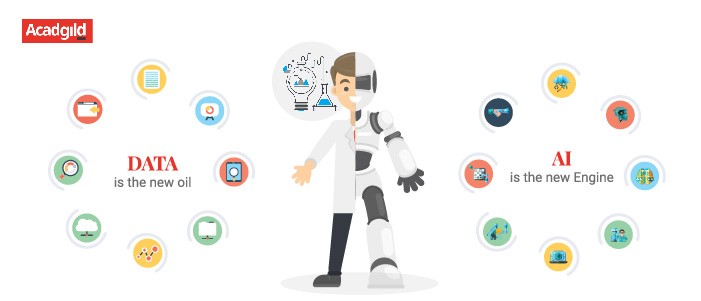You can find, a lot of companies these days are investing into data & artificial Intelligence (AI). At various places, these can be called from different terms like Advance Analytics, Big Data Analytics, Data Science or machine learning but the purpose of these is more or less same and that is to provide more efficient data driven products or services to the clients and customers. An organization needs to be smart in terms of processes and the services in this challenging competitive market which runs on digital economy. In this age, smartness in the processes and products comes through artificial intelligence.
To assess how mature an organization is on their data and AI, we must look at what actually they are doing with their data. Those companies who are not mature enough to handle may miss certain dots which connects each other to form the right team. It means, they may not hire data scientist but data engineers which results in not delivering what was expected.
Due to the enhancement in awareness of Data & AI, many organizations adopted these and started off Data and AI programs with the expectations to increase the business. Many of them may not met the set expectations and leaders of these programs were unhappy with the progress. Data and AI projects are still coming under the heading of niche Projects. All big tech giants like Amazon, Google, Apple, Facebook etc. used the altogether different strategies to gain the market dominance in their niche sectors. They worked a lot on building capacities, effective processes along with development of different products and services. Those companies who are not so well digitally equipped but established and working with digital immature team faced a lot of difficulties in this transformation. Strong determination and persistence are the important requirements from leadership position to adopt and implement Data & AI in all aspect of decision making inside any organization. This commitment usually reflects like keeping this topic into the high-level meetings like meetings of BoD, Senior Managers meetings.
It has been noticed that in some of the organizations leaders and parallels have the understanding of the importance of Data and AI but due to no or less expertise in this field they feel getting stuck. It can be considered as a positive sign and due to this many institutions (even academics) offer the training in this subject for leaders. They also provide the customized training for leaders and professionals who are highly involved in this subject.
We will see the step-by-step process to understand how can Data & AI be defined and executed
- Vision Development of Data & AI understanding the business goals is the must preface to develop the vision of Data & AI. Data & AI will be going to affect the business decisions in most of the ways, so before adopting it, it’s better to understand the future goals of the organization.
- Governance of Data and Data Asset data can be called as asset if it is according to the FAIR principle. FAIR stands for Findable, Accessible, Interoperable & Reusable. It has been suggested by EU Horizon 2020 program in 2016. Data which does not contain all these attributes are not asset and it will take little longer to process and again it will help the business decisions. Second principle like ‘Build Once – Use Many’ is the basic of developing of Data Asset. E-commerce can be one prime example of this. Data collected through CRM channels, the user behavior data, online and offline consumer behavior must be attributed properly and must be applicable on both principles discussed above. These attributed data can be used in many ways and can be called as asset for an organization which will help to build better services and products. Starting with the data which is most important and on top most priority is the first step to building the Data Asset of any organization. But in many organizations, it has found to a disconnect between IT tam and business decision maker team which ends up creating a frustration at both ends. One of the practical ways to reduce this disconnect is to create Data Inventory based on the FAIR principle.
- Technology & Solution Architecture the technical side of Data Asset is known as Technology and Solution Architecture. Those who are not the native digital organizations have an ample of legacy infrastructure. One of the most important tasks for these companies is to hire an experienced Data Architect after completing the both steps mentioned above. The Data Architect will help the organization to assess the current technical architecture and define the targeted technical architecture with the help of creating the proper roadmap. This activity must be followed by integrating the different channels of Data collection like CRM, Data warehouses, Cloud and Analytics along with Business Interface channels. The transition of traditional IT infrastructure to Digital Organization is often a lengthy process. During the transition process, the cost may eventually grow up as the new and old infrastructure live side by side, but at the end of the process, AI and Data helps to reduce the cost.
- Data Protection & Privacy data Protection & Privacy refers to the collection, usage and maintaining the privacy of the collected data. According to General Data Protection Regulation (GDPR) of European Union, the legitimate interest of data processing must be defined and the user informed about the collection, processing, and combination of their data. The user must be offered mechanisms to opt out and object data processing. The level of user identification between data flows between different data-processing systems must be defined. While collecting and using data of consumer, visitor, clients etc., an organization must reveal the Data Privacy Policy to each of the stakeholder of the business as per the desired use of AI after transition. This helps in avoiding the situation in future where data will be used for custom purposes. Privacy Policy of an organization must be developed after discussion with IT team/Data Scientists/Data Architecture who is going to collect and process data to make it insightful information, business decision making team who will be using the data and the lawyers who will be drafting the same. People with technical IT background will help others members of the team that how data will be collected and how it will be processed to have everyone a better understanding of the same which will further help to draft the best possible Privacy Policy.
- Human Skills the transition process of Data & AI, the end will require new skill set in the organization. An organization needs to hire people with those required skillset. Data & AI driven organization will require at least 4 skillsets as mentioned below: –
- Business Functions
While hiring the people for business functions. Profit & Loss Centers, an organization will have to hire people who have literacy in Data. Business mostly communicates with other businesses. The AI & Data team helps to convert the business vision and goals into data requirement which helps to collect the actual required data.
- Data Science & Business Intelligence
After successful transition from traditional IT infrastructure to Data & AI module, the requirement of Data Science & Business Intelligence becomes inevitable. The Data Science people may have different academic backgrounds but the common will be Statistics & Econometrics background. The Data Science team helps to gather and process those data to convert it into insightful information. It is recommended that an organization must hire a Senior Data Scientist and let him/her make his own team as per the customized needs.
- Data Asset Management
Data Asset Management becomes one of the important departments to handle after transition. Data Asset Management team helps all data warehouse and data in FAIR principle.
- Data Platforms & Technical Solutions
- Data & AI organization the size of company size and organization, culture, the level of AI maturity in the team and the leadership are some of the basic measurement to deduce the optimization of Data & AI for any company. Depending on these factors, while transition period an organization needs to establish a Centre of Excellence with the agenda of Data & AI. This team should focus only on Data & AI adoptability in all the different departments. This department must consist of technical people like Data Scientist and business leader of the company. Different organizations have different focus area and goals. Priority of business goals must be in the center while developing Data & AI organization. The operating model of this team should be in the integration of Business Leaders and Data Experts. From business point of view, budgets should be centralized for the team which will drive the team to scale up the operations. To achieve the target, the team should also prepare a roadmap, prioritize the goals with governance clarity which will lead this team to contribute most to the business.
- AI & ML Algorithm’s data & AI in organization have the basic working way which is based on Algorithms. Algorithms are the connectors which helps to capture any change in data. This means, it becomes one of the most important pillars in any organization which is in the period of transition or successfully done it. Data Science cannot be applicable without the presence of algorithms. It becomes important to maintain and save the algorithms created. It is recommended that, algorithms must be treated like Data. It should also have an Algorithm Asset as Data have. This will help the Data Science team to be more effective and efficient. An organization must have a repository to stock all the algorithms like codes with all standards.
Concluding the topic, we can say that the Data & AI have the power to reduce costs, to advance the business decisions, to help different department inside the company to provide better services and to develop better products to offer. Below are some summarized steps which must need to be taken while considering Data & AI for your organization
- Envision the development of Data & AI as per the needs of your organization
- Defining Data & AI roles for your organization with the clarity of the current IT infrastructure
- Execution of Data & AI keeping the clear-cut target in vision
- Scaling up the business operations



